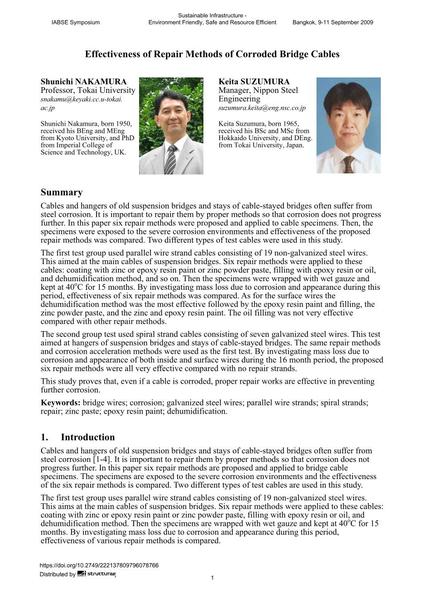Effectiveness of Repair Methods of Corroded Bridge Cables

|
|
|||||||||||
Bibliografische Angaben
| Autor(en): |
Shunichi Nakamura
Keita Suzumura |
||||
|---|---|---|---|---|---|
| Medium: | Tagungsbeitrag | ||||
| Sprache(n): | Englisch | ||||
| Tagung: | IABSE Symposium: Sustainable Infrastructure - Environment Friendly, Safe and Resource Efficient, Bangkok, Thailand, 9-11 September 2009 | ||||
| Veröffentlicht in: | IABSE Symposium Bangkok 2009 | ||||
|
|||||
| Seite(n): | 76-85 | ||||
| Anzahl der Seiten (im PDF): | 8 | ||||
| Jahr: | 2009 | ||||
| DOI: | 10.2749/222137809796078766 | ||||
| Abstrakt: |
Cables and hangers of old suspension bridges and stays of cable-stayed bridges often suffer from steel corrosion. It is important to repair them by proper methods so that corrosion does not progress further. In this paper six repair methods were proposed and applied to cable specimens. Then, the specimens were exposed to the severe corrosion environments and effectiveness of the proposed repair methods was compared. Two different types of test cables were used in this study. The first test group used parallel wire strand cables consisting of 19 non-galvanized steel wires. This aimed at the main cables of suspension bridges. Six repair methods were applied to these cables: coating with zinc or epoxy resin paint or zinc powder paste, filling with epoxy resin or oil, and dehumidification method, and so on. Then the specimens were wrapped with wet gauze and kept at 40oC for 15 months. By investigating mass loss due to corrosion and appearance during this period, effectiveness of six repair methods was compared. As for the surface wires the dehumidification method was the most effective followed by the epoxy resin paint and filling, the zinc powder paste, and the zinc and epoxy resin paint. The oil filling was not very effective compared with other repair methods. The second group test used spiral strand cables consisting of seven galvanized steel wires. This test aimed at hangers of suspension bridges and stays of cable-stayed bridges. The same repair methods and corrosion acceleration methods were used as the first test. By investigating mass loss due to corrosion and appearance of both inside and surface wires during the 16 month period, the proposed six repair methods were all very effective compared with no repair strands. This study proves that, even if a cable is corroded, proper repair works are effective in preventing further corrosion. |
||||
| Stichwörter: |
Korrosion Reparatur
|
||||
